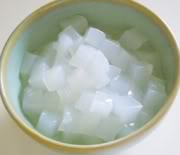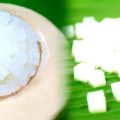Nata de Coco is a product of fermentative action of Acetobacter xylinum- a thick translucent, gelatinous food product. Nata de coco can be sweetened as desserts or candies. It is commonly used as an ingredient in sweet fruit salads, pickles, fruit cocktails, drinks, ice cream, gourmet dishes and other recipes. Nata de Coco is one of the highest sources of insoluble dietary fiber, carbohydrate, vitamins and minerals, no cholesterol and low in fat.

Starting a business in nata de coco production generates labor, employment and money. This livelihood endeavor is ideal in the country’s coconut producing areas.
Estimated Investment Cost (based in 2009 prices)
I. Estimated Cost of Utensils
- Weighing scale – P199.75
- 1 straining cloth – 25.00
- Stainless/enamel kettle – 800.00
- Fermenting basin or Jar (@Php61.75/basin x 30/hr x 8 hrs) – 14,820.00
- Total – P15,844.75
II. Estimated Cost of Packaging Materials
- Sterilized glass jar with cap – P12.94
- Cap sealer (100 pcs/P25.00) – 0.25
- Total – P13.19
III. Estimated Cost of Raw Materials/Ingredients
a. Nata de Coco grower
- 1 kilo fresh coconut, grated – P 51.00
- 400 ml of glacial acetic acid – 108.00
- 2 kgs of refined sugar – 71.50
- 24 liters tap water –
- 2 liters nata starter – 41.67
- Total for 1 kilo raw nata de coco – P272.17
b. In Heavy Syrup
- 3/4 kg. refiner sugar – P26.81
- 0.1% citric acid – 0.99
- Total for 1 kilo raw nata de coco – P27.80
Procedure
A. Nata de Coco grower
- Mix grated coconut with water. Extract milk thru straining cloth.
- Dissolve sugar and add the rest of the ingredients and mix thoroughly.
- Pour 4 cups of mixture into clean sterile fermenting basins or jars (2 inches depth).
- Cover with manila paper and set aside undisturbed for 8-10 days.
- Harvest nata (approximately a minimum of 15 kilos and maximum of 30 kilos) and wash.
Note: Always use clean and potable water and sterilize utensils and plastic containers.
B. Nata da Coco in Heavy Syrup
- Nata used for processing should be smooth, white in color, firm in texture and preferably 1 to 1.5 cm. in thickness.
- Soak newly harvested nata in water to facilitate removal of scum. Scrape off the milky curd. Wash thoroughly.
- Cut the nata de coco uniformly into desired size, preferably 1.5 x 1.5 inch.
- Remove the sour taste and odor completely by soaking in water for 2 days in several changes of water until acidic taste or smell is completely removed.
- Boil in water. Drain. Weigh.
- For 1 kg. of nata de coco, add 3/4 kg. of refined sugar. Mix thoroughly and let it stand overnight.
- Boil for 10-15 minutes or until nata becomes transparent. Desired flavoring may be added.
- Drain, set aside the syrup.
- Prepare syrup by boiling 2 parts water and one part sugar.
- Combine with syrup from the drained nata.
- Add 0.1% citric acid for every 1000 ml of syrup.
- Pack nata in dry, sterilized glass jars. Pour hot syrup.
- Remove air bubbles. Cover tightly.
- Sterilize for 30 minutes.
- Cool, label, and store.
IV. Estimated Costing and Pricing
Assumptions:
- For every 10 days, the average harvest of Nata de Coco is 20 kilos.
- Nata de Coco production is twice a month, totaling 4 working days/month for the production of Nata de Coco grower (2 working days) and Nata do Coco in heavy syrup (2 working days).
V. Product Costing
A. Direct Cost
- Raw materials/ingredients (P272.17+27.80 x 8 hour-work x 2 production) – P4,799.52
- Packaging material (P13.19x 469 bottles x 2 production) – 12,372.22
- Labor cost (P382/day x 4 days) – 1,52800
- Total Direct Cost – P18.699.74
B. Indirect Cost
- Water (P220 consumption/22 days x 4 days) – P40.00
- LPG (P500/22 days x 4 days) – 90.92
- Contingency cost (10% of Direct Cost) – 1,476.41
- Total Indirect Direct Cost – P1,607.33
C. Production Cost
- A+B (production cost of approximately 938 bottles) – P20,307.07
D. Product Pricing
- Production cost per 12 oz. bottle – P21.65
- 20% mark-up of the Production Cost – 4.33
- Suggested Market Price – P25.98
Market Price per 12 oz. bottle: from P28.75 to P36 (as of March 2009)
Source of packaging materials: Synergos Management, Inc. (02) 712-7030, 711-0257
Registration Requirements
- Business name registration (www.bnrs.dti.gov.ph)
- Mayor’s/Business Permit (check your local municipality/city)
- BIR TIN (www.bir.gov.ph)
- BFAD Certificate (www.bfad.gov.ph)
Financing Facility
- People’s Credit and Finance Corp (www.pcfc.gov.ph)
- Small Business Corp. ([02] 751-1888)
Technical Assistance (Training and Seminar)
- DA-BPI ([02] 524-0779, 525-7909/7658)
- DOST-STII ([02] 837-2191 to 95, www.stii.dost.gov.ph)
- DTI-PTTC (www.pttc.gov.ph)
- DOST, R&D (http://itdi.dost.gov.ph)
Nata de coco starter is available at Industrial Technology Development Institute
DOST Compound, Gen. Santos Ave., Bicutan, Taguig City, Philippines 1631
Tel Nos.: (632) 8372071 to 82 locs 2182, 2218, 2180; Telefax Nos.: (632) 8373167, 8376150, 8376156
website: http://itdi.dost.gov.ph
source: dti.gov.ph Photo: tulisanpuji.blogspot.com







how can i purchase the nata starter? What is the packing size? Please email me the information.
Good day! May I kindly request for a list of possible supplier of equipment to be used as slicer/cutter of nata de coco. The nata de coco will be used as sinker for milk tea and other beverages alike.
Your reply will be greatly appreciated.
If you need bottles packaging, please visit the website – www.synergospackaging.com . Thanks! God bless!